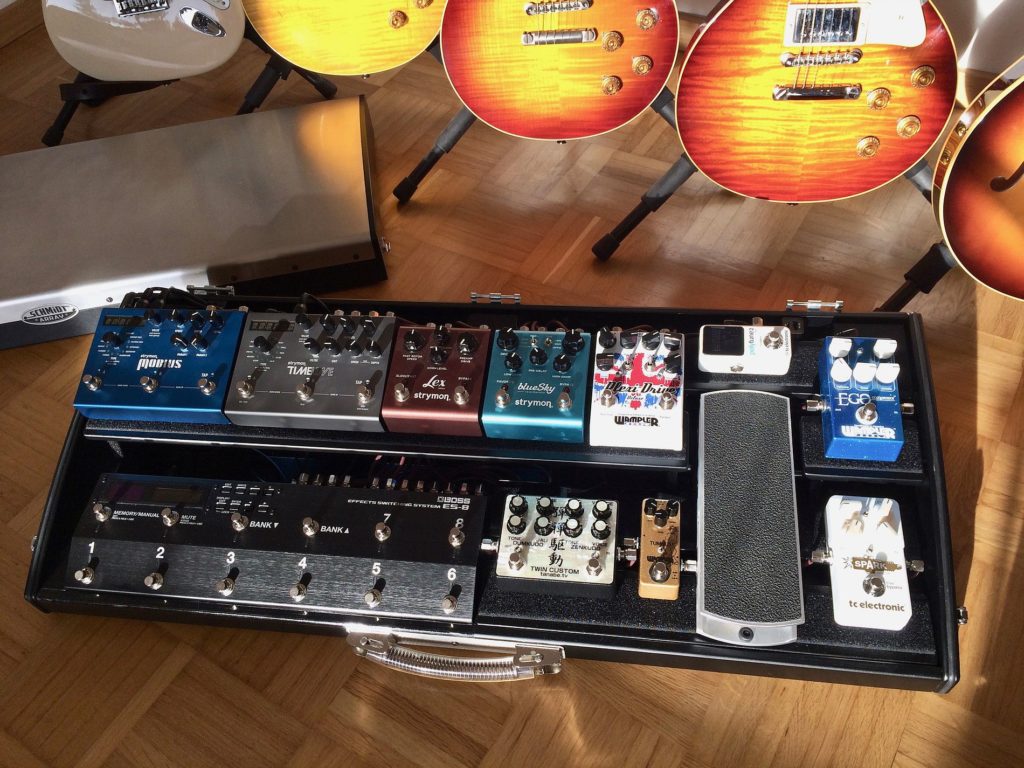If you’ve used more than one distortion pedal at a time, you’ve officially stacked pedals. It’s that straightforward. Depending on your pedals and settings, your experiments may have met with mixed results, but the basic idea is solid; use one gain pedal to boost or color the sound of another.
Stacking overdrive/gain/boost/distortion/fuzz pedals can accomplish a variety of goals. One option is to set them up to be multiple gain stages. A clean amp with a light-heavy gain pedal stacking is quite common. When dialed-in correctly, these can be four distinct sounds: clean, dirty, heavy, or saturated.
Fuzz pedals add a different color palette to your overall sound, but they work the same way as any other drive pedal. For example, if your fuzz pedal sounds better to you at high gain, treat it as a heavier gain pedal. If it sounds better at a lower gain setting, treat it like a lower gain pedal.
You can also use stacks of drive pedals to change the overall character of your existing gear. For a different set of sounds, start with a pedal that has the tonal characteristics of a specific amp, ideally one that is different from your amp. Then stack that pedal with another flavor of gain, and you’ve got two distinct amp tones that can be overdriven.
Starting off with a clean amp sound will offer more variety and flexibility if you’re stacking gain pedals; the differences will be more audible. However, the concept can also work with a dirty amp. Obviously, the less distorted your amp setup is, the more you can influence the sound with the drive pedals.
Tips for Stacking Pedals
Here are 5 tips to understand when starting to stack pedals:
- The last pedal in the stack has the most influence on the overall tone.
- A clean boost can be used as a gain boost versus an overdrive pedal, or a volume boost if placed afterward.
- Some pedals are great for specific jobs. Transparent units are great for adding gain or boost to a sound you don’t want to alter, such as a second channel or gain stage. TS-style units boost mids, lower highs and lows, and add some compression and some clean, distortion-free signal to the mix. These are great for making a soloist stand out or for reinforcing a thick rhythmic sound.
- It is important to find the optimal gain setting between pedals. Too much gain or level can cause excessive hiss or hum, weird handling noise, EQ, and compression, and can make your sounds appear smaller. Of course, there are times when sheer cacophony may be exactly what you’re looking for.
- All drive pedals have an inherent EQ curve and sound. Knowing what that curve is will help you know how and where to stack a pedal. To find out what your pedal sounds like, try these steps:
- Start with the EQ controls set to flat (usually 12:00).
- Set the gain control to 9:00 or 10:00, lower if the pedal still responds correctly.
- Match the volume control so that the level is the same when the pedal is on / off.
- Play a chord with the pedal turned off. Turn on the pedal and play the same chord. Listen to the EQ differences in the two sounds. Are there more or less means? Does the low end change noticeably? Are the maximums the same?
- Increase the gain incrementally and toggle between on and off. Does the character of the pedal change? Is it a good thing?
- Use the volume control knob as well. Some pedals sound better turned up or make the amp louder.








